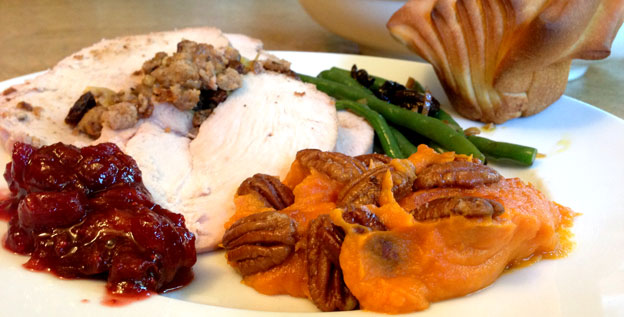(Skip the gabble; get ready to gobble! Go straight to the recipe for puréed sweet potatoes with Grand Marnier and buttered pecans.)
A sudden cacophony of pin-ball machine clangs, rings, and pings deluged the sunny room where I was working. I jumped in my seat. It was my phone, set to the most annoying ringtone possible. On the other end was the DH, at the supermarket: “Hey.”
“What’s up?”
“Did you mean to have yams and potatoes on the list?”
“Er…. No? Why do we need to have yams and potatoes?”
“How can we have Halfgiving without yams or potatoes?”
Let me explain: my family loves Thanksgiving. Not that we have a zeal for proto-American why-can’t-we-all-just-get-along historical fantasies. For us, it’s a celebration of fabulous late-fall harvest food and a momentary pause to recall the many blessings in our lives. (And if I keep saying the second part, maybe the DD and the DS will actually believe it one day!) We love Thanksgiving so much that not only do we celebrate Thanksgiving, we make more sides to join the leftovers in the days following Turkey Thursday (who needs Black Friday?) because even we recognize that it would be a tad crazy to try to make all the dishes we absolutely can’t do without on Thanksgiving Day itself. We love it so much that a few years ago, the kids declared that we also need to celebrate Halfgiving, six months after Thanksgiving. So every year, on the weekend following the fourth Thursday in May, we make Thanksgiving Dinner Lite.
So when the DH made his urgent call from the grocery store, I knew I had crossed the line. You see, I had planned on making the buttery fantail rolls that we all love, plus stuffing, so I thought that would more than take care of carbs for the four of us. What was I thinking!? Who am I to tamper with Tradition? Yams were duly, and speedily, added back into the lineup. It was really a no-brainer; we’ve been making these heady, citrusy yams for Thanksgiving since before the kids were born. And, yeah, yeah: technically, they’re sweet potatoes (so that’s the way I’ve labelled them in the recipe), but I grew up calling them yams, and between you and me, that’s what I’m going to keep calling them.
Here’s our final menu for Halfgiving 2013:
- Grilled, stuffed turkey breast
- Green beans with walnuts and dried-cherry dressing
- Puréed yams with Grand Marnier and pecans
- Buttermilk fantail rolls
- Cranberry-orange sauce
- Gravy
It’s not as extravagant as the actual holiday, but it tides us over until November when we can really do it up right. BTW, the DD and DS are still lobbying for Halfmas, but we’ve told them not to hold their breaths.

Recipe: Puréed sweet potatoes with Grand Marnier and pecans
Serves 5-6
Ingredients
- 2 cups pecan halves
- 5 tablespoons unsalted butter, softened, divided
- 1 teaspoon coarse kosher salt
- 4 large orange-fleshed sweet potatoes (like Red Dianes, often labelled “yams”), about 4 lbs.
- 2 tablespoons Grand Marnier, or another orange-flavored brandy liqueur
- ½ teaspoon salt
- 2 tablespoons packed light brown sugar
Preparation
Preheat oven to 325°F. Place pecans in a shallow roasting pan in one layer. Roast in the middle of the oven until fragrant, about 8 minutes. Remove from the oven, and immediately toss with 1 tablespoon of the butter and kosher salt, stirring until coated evenly. (The pecans can be made up to 2 days ahead, cooled to room temperature, and stored in an airtight container.)
Increase oven temperature to 425°F. Prick each sweet potato 6-8 times all over. Place on a roasting pan lined with parchment paper or foil. Roast them in the middle of the oven until easily pierced through the middle by a fork, about 1 hour.
Reduce the oven temperature to 325°F.
As soon as the sweet potatoes are cool enough to handle, peel half of them them, and place them in the work bowl of a food processor. Add 2 tablespoons of Grand Marnier, ¼ teaspoon of salt, and 2 tablespoons of butter. Purée the sweet potato mixture until smooth. Scoop the purée into a gratin dish. Repeat with the rest of the sweet potatoes, Grand Marnier, salt, and butter. Level the sweet potato mixture in the casserole dish. (The sweet potatoes can be made up to this point a day ahead. Cool and cover before storing in the refrigerator. Bring to room temperature before proceeding.)
Arrange the pecans in one layer over the top of the sweet potato purée, and sprinkle with the brown sugar. Bake in the middle of 325°F oven until heated through and pecans are slightly browned, approximately 30 minutes (or, 35-40 minutes, if starting from room temperature purée).


